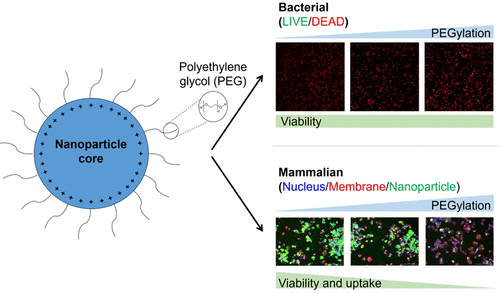当前位置:
X-MOL 学术
›
Biomacromolecules
›
论文详情
Our official English website, www.x-mol.net, welcomes your feedback! (Note: you will need to create a separate account there.)
Optimization of Cationic Nanogel PEGylation to Achieve Mammalian Cytocompatibility with Limited Loss of Gram-Negative Bactericidal Activity.
Biomacromolecules ( IF 6.2 ) Pub Date : 2020-03-24 , DOI: 10.1021/acs.biomac.0c00081 Joann Gu , John R Clegg , Lara A Heersema , Nicholas A Peppas 1 , Hugh D C Smyth 2
Biomacromolecules ( IF 6.2 ) Pub Date : 2020-03-24 , DOI: 10.1021/acs.biomac.0c00081 Joann Gu , John R Clegg , Lara A Heersema , Nicholas A Peppas 1 , Hugh D C Smyth 2
Affiliation

|
Tuning the composition of antimicrobial nanogels can significantly alter both nanogel cytotoxicity and antibacterial activity. This project investigated the extent to which PEGylation of cationic, hydrophobic nanogels altered their cytotoxicity and bactericidal activity. These biodegradable, cationic nanogels were synthesized by activators regenerated by electron transfer atom transfer radical polymerization (ARGET ATRP) emulsion polymerization with up to 13.9 wt % PEG (MW = 2000) MA, as verified by 1H NMR. Nanogel bactericidal activity was assessed against Gram-negative E. coli and P. aeruginosa and Gram-positive S. mutans and S. aureus by measuring membrane lysis with a LIVE/DEAD assay. E. coli and S. mutans viability was further validated by measuring metabolic activity with a PrestoBlue assay and imaging bacteria stained with a LIVE/DEAD probe. All tested nanogels decreased the membrane integrity (0.5 mg/mL dose) for Gram-negative E. coli and P. aeruginosa, irrespective of the extent of PEGylation. PEGylation (13.9 wt %) increased the cytocompatibility of cationic nanogels toward RAW 264.7 murine macrophages and L929 murine fibroblasts by over 100-fold, relative to control nanogels. PEGylation (42.8 wt %) reduced nanogel uptake by 43% for macrophages and 63% for fibroblasts. Therefore, PEGylation reduced nanogel toxicity to mammalian cells without significantly compromising their bactericidal activity. These results facilitate future nanogel design for perturbing the growth of Gram-negative bacteria.
中文翻译:

阳离子纳米凝胶聚乙二醇化的优化,以实现革兰氏阴性杀菌活性的有限损失的哺乳动物细胞相容性。
调整抗菌纳米凝胶的组成可以显着改变纳米凝胶的细胞毒性和抗菌活性。该项目研究了阳离子,疏水性纳米凝胶的聚乙二醇化改变其细胞毒性和杀菌活性的程度。这些可生物降解的阳离子纳米凝胶是通过活化剂合成的,该活化剂通过电子转移原子转移自由基聚合(ARGET ATRP)乳液聚合与13.9重量%PEG(MW = 2000)MA进行再生,经1 H NMR验证。通过使用LIVE / DEAD分析测量膜裂解来评估纳米凝胶对革兰氏阴性大肠杆菌和铜绿假单胞菌以及革兰氏阳性变形链球菌和金黄色葡萄球菌的杀菌活性。大肠杆菌和变形链球菌的生存力通过使用PrestoBlue分析测量代谢活性并用LIVE / DEAD探针对细菌染色进行成像来进一步验证。所有测试的纳米凝胶均降低了革兰氏阴性大肠杆菌和铜绿假单胞菌的膜完整性(0.5 mg / mL剂量),无论PEG化程度如何。相对于对照纳米凝胶,聚乙二醇化(13.9 wt%)使阳离子纳米凝胶对RAW 264.7鼠巨噬细胞和L929鼠成纤维细胞的细胞相容性提高了100倍以上。聚乙二醇化(42.8 wt%)使巨噬细胞的纳米凝胶吸收降低了43%,成纤维细胞的纳米凝胶吸收降低了63%。因此,PEG化降低了纳米凝胶对哺乳动物细胞的毒性,而没有显着损害其杀菌活性。这些结果促进了未来用于干扰革兰氏阴性细菌生长的纳米凝胶设计。
更新日期:2020-04-23
中文翻译:

阳离子纳米凝胶聚乙二醇化的优化,以实现革兰氏阴性杀菌活性的有限损失的哺乳动物细胞相容性。
调整抗菌纳米凝胶的组成可以显着改变纳米凝胶的细胞毒性和抗菌活性。该项目研究了阳离子,疏水性纳米凝胶的聚乙二醇化改变其细胞毒性和杀菌活性的程度。这些可生物降解的阳离子纳米凝胶是通过活化剂合成的,该活化剂通过电子转移原子转移自由基聚合(ARGET ATRP)乳液聚合与13.9重量%PEG(MW = 2000)MA进行再生,经1 H NMR验证。通过使用LIVE / DEAD分析测量膜裂解来评估纳米凝胶对革兰氏阴性大肠杆菌和铜绿假单胞菌以及革兰氏阳性变形链球菌和金黄色葡萄球菌的杀菌活性。大肠杆菌和变形链球菌的生存力通过使用PrestoBlue分析测量代谢活性并用LIVE / DEAD探针对细菌染色进行成像来进一步验证。所有测试的纳米凝胶均降低了革兰氏阴性大肠杆菌和铜绿假单胞菌的膜完整性(0.5 mg / mL剂量),无论PEG化程度如何。相对于对照纳米凝胶,聚乙二醇化(13.9 wt%)使阳离子纳米凝胶对RAW 264.7鼠巨噬细胞和L929鼠成纤维细胞的细胞相容性提高了100倍以上。聚乙二醇化(42.8 wt%)使巨噬细胞的纳米凝胶吸收降低了43%,成纤维细胞的纳米凝胶吸收降低了63%。因此,PEG化降低了纳米凝胶对哺乳动物细胞的毒性,而没有显着损害其杀菌活性。这些结果促进了未来用于干扰革兰氏阴性细菌生长的纳米凝胶设计。



























 京公网安备 11010802027423号
京公网安备 11010802027423号